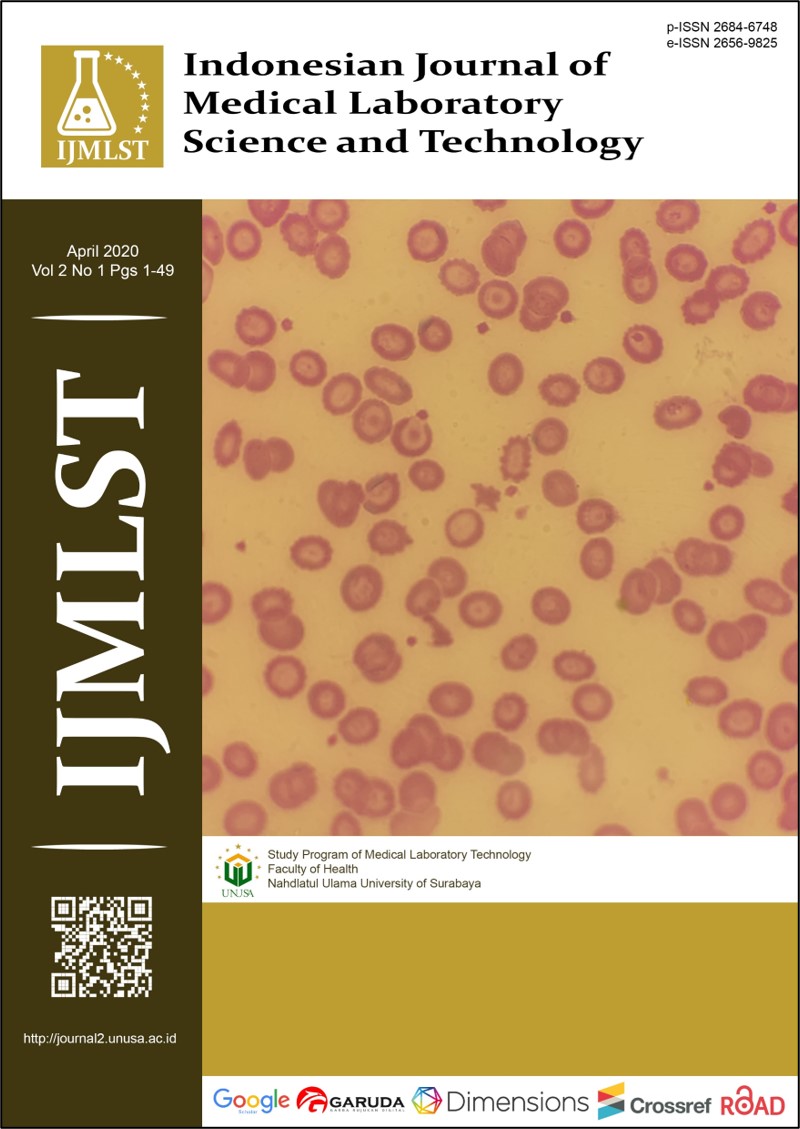A POWERFUL ELISA TECHNIQUE TO TEST THE POTENTIAL OF EXTRA VIRGIN OLIVE OIL IN REDUCING TNF-Α LEVEL AND EDEMA VOLUME IN MALE Rattus norvegicus EXPOSED TO CARRAGEENAN
Main Article Content
Abstract
Extra virgin Olive oil is extracted from fruit that can be used as anti-inflammatory agent. This research aimed to test the potential of extra virgin olive oil in reducing edema volume and TNF-α plasma in carrageenan-induced rats. This research was purely experimental research with the post test control group design. A total of twenty eight Wistar rats were divided randomly into four treatment groups. Group I was a control negative group, while the group II, III, and IV were orally administered with extra virgin Olive oil at the dose of 0.9 ; 1.8 ; 2.7 mL/day, respectively. Paw edema was measured one hour before the rats was induced to carrageenan and every hour until four hours after it was induced to carrageenan. TNF-α plasma was measured at four hours. Analysis of the data was done by calculating the presentation of edema inhibition in every group, then the data was statistically analyzed by Anova, Repeated Anova, LSD and Kruskal Wallis test with 95% confidence interval. The result showed that extra virgin olive oil has an anti-inflammatory effect. The highest decrease in edema volume percentage was in group III (14.21%). There was a significant difference in the edema volume of all treatment groups at each time of the experiment with TNF-α value (p < 0.05). In conclusion, the administration of extra virgin olive oil can lower the volume of carrageenan-induced edema in rats depend on the dose. Also, the administration of extra virgin olive oil can be dose-dependent in reducing the levels of TNF-α in carrageenan-induced edema in rats.
Downloads
Article Details
Copyright (c) 2020 Andina Putri Aulia, Suprapto Maat, Aryati

This work is licensed under a Creative Commons Attribution-ShareAlike 4.0 International License.
References
Dhivya S, Vijaya V, Santhini E. Review article Wound dressings – a review. BioMedicine. 2015;5(4):24–8.
Lei J, Sun L, Li P, Zhu C, Lin Z, Mackey V, et al. The Wound Dressings and Their Applications in Wound Healing and Management. Heal Sci J. 2019;13:1–8.
Shabunin AS, Yudin VE, Dobrovolskaya IP, Zinovyev E V, Zubov V, Ivan EM, et al. Chitin / Chitosan Nanofibers : Processing and Biomedical Applications. Cosmetics. 2019;6:1–10.
Andini A, Prayekti E. Chitosan as Antifungal in Channa striata Collagen-Chitosan for Wound Healing. Med Heal Sci J. 2019;3(2):8–11.
Leliani HN, Seniwati DS. Collagen Extraction from Bone Of Lutjanus Sp. and Toxicity Assay. Indones Chim Acta. 2019;12(1):67–72.
Mennini N. Quality of wound dressings: A first step in establishing shared Criteria and objective procedures to evaluate their performance. J Wound Care. 2016;25(October 2017).
Kumar PTS, Lakshmanan V, Anilkumar T V, Ramya C, Reshmi P, Unnikrishnan AG, et al. Retraction of “Flexible and Microporous Chitosan Hydrogel/Nano ZnO Composite Bandages for Wound Dressing: In Vitro and In Vivo Evaluation.” ACS Appl Mater Interfaces. 2019;11:28596.
Ariyadi T, Dewi SS. Pengaruh Sinar Ultra Violet terhadap Pertumbuhan Bakteri Bacillus sp. sebagai Bakteri Kontaminan (Effect of Ultra Violet Rays on the Growth of Bacillus sp. as Contaminant Bacteria). J Kesehat. 2009;2:20–5.
B.N Meyer, N.R. Ferrigni, J.E Putnam, L.B Jacobsen, D.E Nichols J. M. Brine Shrimp : A Convenient General Bioassay for Active Plant Constituents. J Med Plant Res. 1982;45:31–4.
Muaja AD, Koleangan HSJ, Runtuwene MRJ. Uji Toksisitas dengan Metode BSLT dan Analisis Kandungan Fitokimia Ekstrak Daun Soyogik ( Saurauia bracteosa DC ) dengan Metode Soxhletasi (Toxicity Assay using BSLT Method and Phytochemical Content Analysis of Soyogik Leaf Extract (Saurauia bracteosa DC) using Soxhletation Method). J MIPA Unsrat Online 2. 2013;2(2):115–8.
Antonio C, Silva DS, Andrade NJ De, Fátima N De, Soares F, Ferreira SO. Evaluation of Ultraviolet Radiation to Control Microorganisms Adhering to Low-Density Polyethylene Films. Brazilian J Microbiol. 2003;34(1517–8382):175–8.
Lei J, Chen P, Li Y, Wang X, Tang S. Collagen hydrogel dressing for wound healing and angiogenesis in diabetic rat models. Int J Clin Exp Med. 2017;10(12):16319–27.
Ou A, Louis H, Pi A, Oc A, Ei N, Ef O. Biochemistry & Pharmacology : Open Access The Chemistry of Chitin and Chitosan Justifying their Nanomedical Utilities. Biochem Pharmacol (Los Angel). 2018;7(1):1–6.





